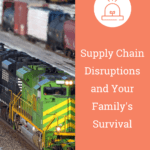Just in time shipping and your family’s survival





Some of the links in this post may contain affiliate links for your convenience. As an Amazon Associate, I may earn a small commission from qualifying purchases without any increase in price to you.
For anyone who wants to be prepared for a potential crisis that could disrupt the supply chain, this post explains how just-in-time delivery, while efficient, can leave families vulnerable in an emergency. Here’s why you need to prepare your family for supply chain disruptions.

Disruptions to the supply chain can leave families scrambling. Food shortages are the ones we seem to notice first. However, there are steps you can take to be prepared. Building a food storage pantry and a stock of essential goods such as medicine can provide a buffer during a shortage. Consider starting a home garden to supplement your diet with fresh produce. Most importantly, gather information! Stay abreast of supply chain news and create a communication plan with loved ones or friends. By being proactive, you can link preparedness efforts together and face disruptions with more confidence.
Back in the day when I clothed my kids in Gymboree from head to toe, the sales clerks could almost always manage to find the size I needed by, “checking in the back.” Every store has a stockroom in the back where, presumably, massive quantities of extra products are shelved. Well, a couple of years ago I was surprised to find out that this isn’t true, Gymboree notwithstanding. In fact, most stores operate on a system known as “just-in-time delivery,” “just- in-time shipping,” or “just in time management.”
Essentially, just-in-time delivery means products arrive just in time to be put on the shelves to replace whatever has been purchased. That’s why, when a store has a particularly good sale on an item, once it’s sold out, it might be out of stock for days or weeks. There is no excess inventory hidden in the back room. Retailers keep inventory levels to a bare minimum in order to save money (and storage space) and to not end up with a stockpile of dead product that isn’t because of customer demand.
One impressive feature of this system is that it’s run by computers and can actually forecast which products will be needed where and when. For example, when the weather in a certain area takes a turn toward higher temperatures, the system will automatically begin shipping items such as sun block and beach toys. An oncoming hurricane will trigger the shipment of bottled water, baby formula and ice. Pretty slick. Now, what does this information have to do with your family’s survival and preparedness?
Imagine there’s a major crisis in our country that slows the shipping business down to a crawl. It could be a natural disaster affecting the busy ports along either coast. Excessively high diesel prices could drive some trucking companies out of business and reduce the amount of goods being shipped via our highways.
The fact that our nation is so very dependent on technology is exactly what makes us so vulnerable, ironically. Just in time shipping has been serving manufacturers, wholesalers, retailers, and consumers very well, but it’s also a fragile system. It depends on our nation’s power grid and ready access to the internet. A power grid shutdown, cyber-terrorism, pandemics, or just mischievous hacking could create a cascade failure of important goods reaching their destinations.
Whatever the event, the just in time shipping strategy may leave the average American family high and dry in the middle of a major crisis.
The American Trucking Association presents a sobering view of possible consequences to a partial or complete interruption to our nation’s trucking business. You should take a few minutes and read the entire paper, but here is a brief summary of a possible timeline in the event of a truck stoppage. (This, of course, doesn’t take into account disruptions in other transportation arenas.)
Shop around, don’t just stick to one store! Instead of relying only on big grocery chains, try shopping at smaller local stores, ethnic markets, or even farmers markets. This way, you’re not putting all your eggs in one basket. If one store runs out of something during a supply chain issue, you’ll have other places to check for what you need.
Connect with friends, family, and neighbors online or in your community. During the toilet paper rush, some stores had plenty while others were empty. People shared info about stores that did have stock. It’s like the recent baby formula shortage – people connected to find (and sometimes ship) extra formula in some states to those facing shortages in others.
Preparedness now is the key. Start keeping track of the goods you buy most often and the most important services your family uses. Virtually every one of them could be affected by a supply chain issue.
Simple steps toward three months or more of food storage may make the difference between your family getting daily, nutritious meals and standing in line with hundreds of other hungry people, hoping to get a few groceries. A home garden will produce fresh produce, and safely storing several gallons of fuel may help you and your family get through the worst of it.
Just-in-time shipping is a system where products are delivered to stores only as they are needed. This minimizes storage costs, keeps shelves stocked with fresh inventory, and reduces dead products that lack consumer demand.
Just-in-time delivery has minimal buffer stock, so any disruption to the flow of goods from supplier to store leaves businesses and families with little time to adapt.

Just in time shipping works well for manufacturers, wholesalers, and retailers but is vulnerable when calamity strikes. Fortunately, families can take advantage of this knowledge by taking prudent steps to safeguard their families regardless of what is on a store’s shelf. Storing inventory is now our job.
This article was originally published on December 18, 2009, and has been updated.
